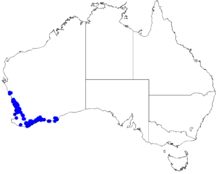Boronia scabra
Boronia scabra, commonly known as rough boronia,[2] is a plant in the citrus family, Rutaceae and is endemic to the south-west of Western Australia. It is an open shrub with simple, often clustered, oblong to elliptic leaves, and pink, mostly four-petalled flowers.
| Rough boronia | |
|---|---|
 | |
| Boronia scabra near Ravensthorpe | |
| Scientific classification | |
| Kingdom: | Plantae |
| Clade: | Tracheophytes |
| Clade: | Angiosperms |
| Clade: | Eudicots |
| Clade: | Rosids |
| Order: | Sapindales |
| Family: | Rutaceae |
| Genus: | Boronia |
| Species: | B. scabra |
| Binomial name | |
| Boronia scabra | |
 | |
| Occurrence data from Australasian Virtual Herbarium | |
Description
Boronia scabra is a shrub that grows to a height of about 60 cm (24 in) and has branchlets with soft hairs. Its leaves are narrow oblong to elliptic with the edges curved downwards, 5–12 mm (0.20–0.47 in) long and often clustered. The flowers are arranged in small groups on the ends of the branches, each flower on a pedicel 2–20 mm (0.079–0.79 in) long. The flowers have four or sometimes five triangular to egg-shaped sepals 2–6 mm (0.08–0.2 in) long. There is a similar number of pink, egg-shaped petals 5–8 mm (0.2–0.3 in) long. The stamens are swollen at the tip with a small white tip on the anther. The stigma is minute. Flowering occurs from July to December.[3][2]
Taxonomy and naming
Boronia scabra was first formally described in 1839 by John Lindley and the description was published in A Sketch of the Vegetation of the Swan River Colony.[4][5] The specific epithet (scabra) is a Latin word meaning "rough", "scurfy" or "scabby".[6]
In 1998, Paul Wilson described three subspecies that are accepted by the Australian Plant Census:
Distribution and habitat
Subspecies attenuata grows among granite rocks at Cape Le Grande and on the nearby Recherche Archipelago,[8][11] subspecies condensata grows near Badgingarra, often in gravel,[8][12] and subspecies scabra grows in a variety of habitats including jarrah forest and kwongan between Geraldton, Gingin, Woodanilling, the Stirling Range and Cape Arid National Park.[8][13][14]
Conservation
Subspecies scabra is classified as "not threatened" by the Western Australian Government Department of Parks and Wildlife[13] but subspecies attenuata is classified as "Priority Three",[11] meaning that it is poorly known and known from only a few locations but is not under imminent threat,[15] and subspecies condensata is classified as "Priority Two" [12] meaning that it is poorly known and from only one or a few locations.[15]
References
- "Boronia scabra". Australian Plant Census. Retrieved 30 April 2019.
- "Boronia scabra". FloraBase. Western Australian Government Department of Parks and Wildlife.
- Duretto, Marco F.; Wilson, Paul G.; Ladiges, Pauline Y. "Boronia scabra". Flora of Australia: Australian Biological Resources Study, Department of the Environment and Energy, Canberra. Retrieved 30 April 2019.
- "Boronia scabra". APNI. Retrieved 7 March 2019.
- Lindley, John (1839). A Sketch of the Vegetation of the Swan River Colony. London: James Ridgway. p. xvii. Retrieved 30 April 2019.
- Brown, Roland Wilbur (1956). The Composition of Scientific Words. Washington, D.C.: Smithsonian Institution Press. p. 670.
- "Boronia scabra subsp. attenuata". Australian Plant Census. Retrieved 30 April 2019.
- Wilson, Paul G. (1998). "New names and new taxa in the genus Boronia (Rutaceae) from Western Australia, with notes on seed characters". Nuytsia. 12 (1): 129–131. Retrieved 30 April 2019.
- "Boronia scabra subsp. condensata". Australian Plant Census. Retrieved 30 April 2019.
- "Boronia scabra subsp. scabra". Australian Plant Census. Retrieved 30 April 2019.
- "Boronia scabra subsp. attenuata". FloraBase. Western Australian Government Department of Parks and Wildlife.
- "Boronia scabra subsp. condensata". FloraBase. Western Australian Government Department of Parks and Wildlife.
- "Boronia scabra subsp. scabra". FloraBase. Western Australian Government Department of Parks and Wildlife.
- Corrick, Margaret G.; Fuhrer, Bruce A. (2009). Wildflowers of southern Western Australia (3rd ed.). Dural: Rosenberg Publishing. p. 192. ISBN 9781877058844.
- "Conservation codes for Western Australian Flora and Fauna" (PDF). Government of Western Australia Department of Parks and Wildlife. Retrieved 30 April 2015.